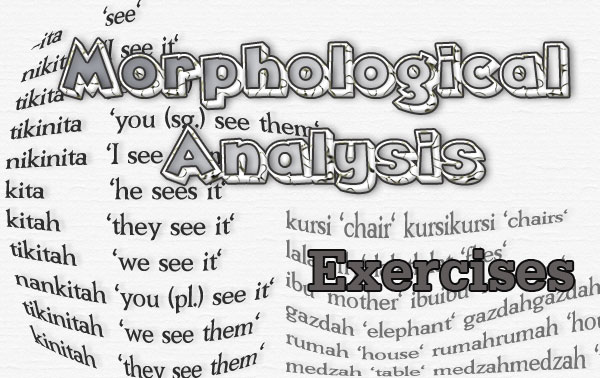This post is about differences between the object in English and Arabic. What are the forms and types of the object? how the object is inflected? what takes place of the object in a sentence?
The object can be defined as the receiver of the action. It could be :
a) a noun or a noun phrase - e.g. : The boy knocked the door.
b) a pronoun - e.g. : The boy knocked it.
c) a clause - e.g.: I love riding my bike.
b) a pronoun - e.g. : The boy knocked it.
c) a clause - e.g.: I love riding my bike.
In English, it is recognized by tracing its relation to word order. It always follows the transitive verb:
John put the bag in the chest.
Jamal bring a bottle to his father.
notice that the object has privileged position in relation to the other complements in that it must immediately follow the verb:Jamal bring a bottle to his father.
*John put in the chest the bag.
*Jamal bring to his father a bottle.
Another fact about the object is that it may undergo certain change when the sentence is passivized:*Jamal bring to his father a bottle.
We eat an apple.
An apple was eaten.
this process is restricted to the object and does not happen to any other kinds of complements:An apple was eaten.
*In the chest was put the bag.
*to his father was brought a bottle.
We have also seen that only verbs and prepositions which have objects, and nouns and adjectives don’t. The NP following the preposition is called prepositional object or object of preposition:*to his father was brought a bottle.
to the market
in the house
On the other hand, like subject pronouns, object pronouns in English have special forms when they occur in the objective case; the object appears in its accusative form as in:in the house
I love him/her/them …
*I love he/she/they …
Complementing what we have mentioned above, some verbs may have more than one object :*I love he/she/they …
The teacher gives John a prize
the two parts of this double construction don’t have the same properties. The one closer to the verb is called Indirect object, it is semantically equivalent to a prepositional phrase:
The teacher gives a prize to John
It refers to the recipient or beneficiary of the action expressed by the verb. While the other that follows this is called the Direct object. It identifies the thing affected by the action expressed by the verb. Moreover, direct and indirect objects are also different in terms of passivization. Only the Indirect object can be passivized:
John was given a prize
but, if the indirect object takes the form of prepositional phrase as in the example ("The teacher gives a prize to John"), then the direct object could be passivized:
A prize was given to John
By and large, the object in English is known grammatically by its position in the sentence. By contrast, in Arabic, unlike English, the object is characterized by the inflections (-a, -an) added at the end of the NP rather than by word order as in:
Akala ahmado attoffahata (Ahmed eat the apple) definite object
Akala ahmado toffahatan (Ahmed eat an apple) indefinite object
The object in Arabic, like in English, could be replaced by pronouns attached to the verb. Interestingly, there are specific pronouns that may take place of the object, bear in mind that they must be attached to the verb to serve the objective case as in:Akala ahmado toffahatan (Ahmed eat an apple) indefinite object
| Ajabaka Ahmadu | (Ahmed answered you) | masculine (singular) |
| Ajabaki Ahmado | feminine (plural) | |
| Ajabakuma Ahmadu | (Ahmed answered you) | plural (both masculine and feminine) |
| Ajabahu Ahmado | (Ahmed answered him) | |
| Ajabaha Ahmado | (Ahmed answered her) | |
| Ajabahuma Ahmado | (Ahmed answered them) | plural (both masculine and feminine) |
| Ajaban(i) Ahmado | (Ahmed answered me) | |
| Ajabana Ahmado | (Ahmed answered us) |
As you see above, the pronouns in black are inflected (in red) to determine the gender or the number of whom the action is assigned to. In this example "Ajaban(i) Ahmado", the long vowel (i) is used to refer to the object.
By analogy with English, there are some Arabic verbs which may have more than one object like in:
Aata Ahmadu saidan alkitaba (Ahmed gives Said the book)
both of them are objects but, this sentence could be interpreted like :
Aata Ahmadu alkitaba li-saidin (Ahmed gives the book to Said)
these two sentences are correct in Arabic. Indeed, we talk about the dative case of the object (Indirect object) which comes after the preposition (li) and the inflection (-in) signs this dative case.To sum up, English and Arabic have some common specifications for the object.









0 Comments